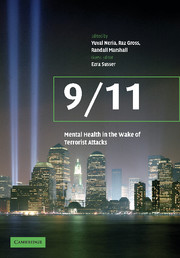Book contents
- Frontmatter
- Contents
- Acknowledgments
- Editors brief bio
- List of contributors
- Foreword
- Part I Introduction
- Part II The psychological aftermath of 9/11
- Part III Reducing the burden: community response and community recovery
- Part IV Outreach and intervention in the wake of terrorist attacks
- Part IV A New York area
- Part IV B Washington, DC
- Part IV C Prolonged-exposure treatment as a core resource for clinicians in the community: dissemination of trauma knowledge post-disaster
- Part V Disasters and mental health: perspectives on response and preparedness
- 29 The epidemiology of 9/11: technological advances and conceptual conundrums
- 30 Searching for points of convergence: a commentary on prior research on disasters and some community programs initiated in response to September 11, 2001
- 31 What mental health professionals should and should not do
- 32 Coping with the threat of terrorism
- 33 Life under the “new normal”: notes on the future of preparedness
- 34 Lessons learned from 9/11: the boundaries of a mental health approach to mass casualty events
- 35 Learning from 9/11: implications for disaster research and public health
- Index
30 - Searching for points of convergence: a commentary on prior research on disasters and some community programs initiated in response to September 11, 2001
from Part V - Disasters and mental health: perspectives on response and preparedness
Published online by Cambridge University Press: 27 October 2009
- Frontmatter
- Contents
- Acknowledgments
- Editors brief bio
- List of contributors
- Foreword
- Part I Introduction
- Part II The psychological aftermath of 9/11
- Part III Reducing the burden: community response and community recovery
- Part IV Outreach and intervention in the wake of terrorist attacks
- Part IV A New York area
- Part IV B Washington, DC
- Part IV C Prolonged-exposure treatment as a core resource for clinicians in the community: dissemination of trauma knowledge post-disaster
- Part V Disasters and mental health: perspectives on response and preparedness
- 29 The epidemiology of 9/11: technological advances and conceptual conundrums
- 30 Searching for points of convergence: a commentary on prior research on disasters and some community programs initiated in response to September 11, 2001
- 31 What mental health professionals should and should not do
- 32 Coping with the threat of terrorism
- 33 Life under the “new normal”: notes on the future of preparedness
- 34 Lessons learned from 9/11: the boundaries of a mental health approach to mass casualty events
- 35 Learning from 9/11: implications for disaster research and public health
- Index
Summary
Close to 100 years ago, after his visit to San Francisco, severely devastated by the 1906 earthquake, William James noted that “In California every one, to some degree, was suffering and one's private miseries were merged in the vast general sum of privation and in the all-absorbing practical problem of general recuperation” (James, 1912, p. 225). These insightful words illuminate two paramount characteristics of community-wide tragedies. Most importantly, whether they are caused by the forces of nature, technological mishaps or errors, or result from premeditated acts of violence and terrorism, they are more than individual-level events. They are “a basic disruption of the social context within which individuals and groups function” (Fritz, 1961, p. 651). Even if they strike geographically bounded environments such as tornados coiling one side of a street, floods submerging a neighborhood along the river banks or explosions shattering the heart of a city, their impact “ripples outward” inflicting harm and damages, and over time creating a greater sense of loss to larger and larger numbers of people. Consequently, the coping efforts aimed at recovery from the oppressive forces of these events become a shared responsibility and collective activity. The chapters presented in this volume all underscored this dynamic interplay of individual and community experiences that emerged in the hours, days, weeks and months in the aftermath of the terrorist attacks of September 11, 2001.
- Type
- Chapter
- Information
- 9/11: Mental Health in the Wake of Terrorist Attacks , pp. 529 - 542Publisher: Cambridge University PressPrint publication year: 2006
- 1
- Cited by

